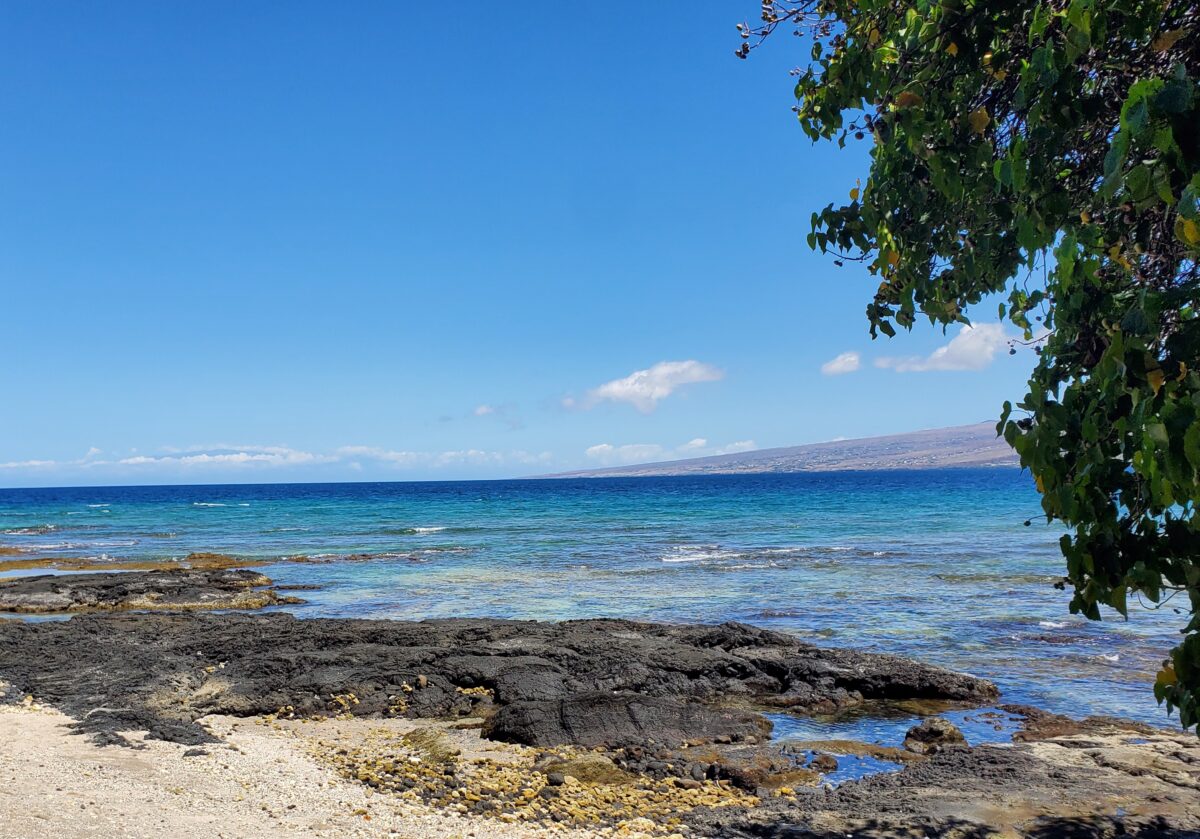If you’re a diver and find yourself on the Big Island of Hawai’i (which is probably not a coincidence) you owe it to yourself to do some shore diving. There is obviously plenty of great boat diving, and I can highly recommend Jack’s Diving Locker for that. But there’s something special about finding your own way to an awesome dive site. You get the experience all to yourself and your buddy(ies). If you want to be lazy about getting in the water, do so. Or if you’re a speed demon, you’re in the water before the boat divers have made it out of the harbor.
And I promise you that the shore diving is every bit as good as most of the boat dives you’ll do. Yeah, you gotta walk/crawl over lava. But for my money, it’s well worth it. Let me tell you about Puako 120. Puako is a little town 40 miles north of Kailua-Kona, immediately north of the Mauna Lani resort. It’s got a road, shockingly called “Puako Road,” that runs from Highway 19 down to the beach. All along it are glorious beach dives. This one is about “120” – you park at the utility pole labeled “120.”
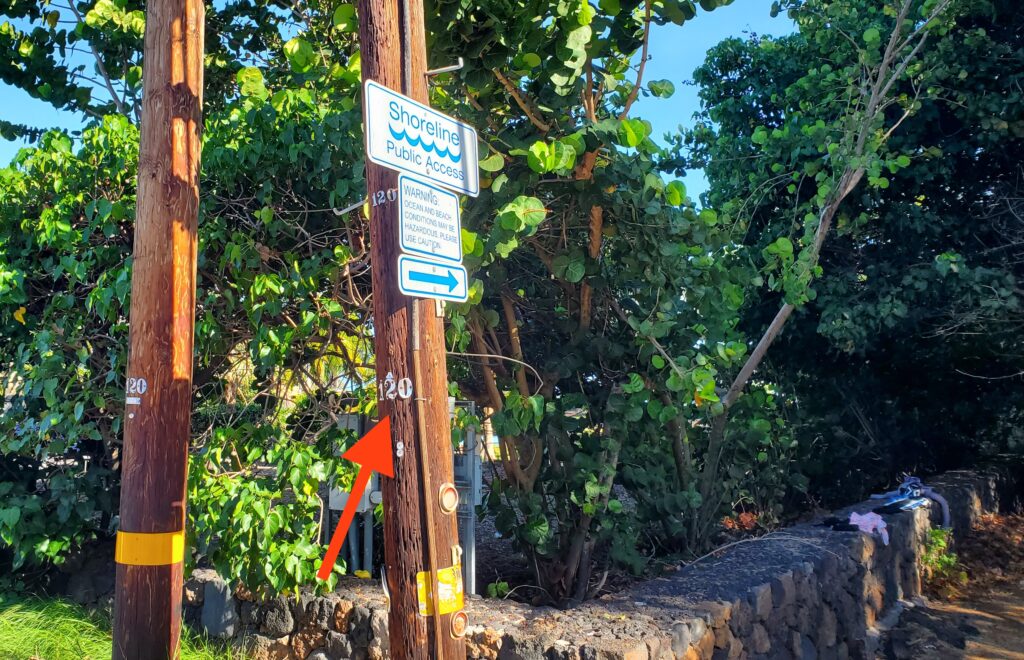
One great thing about Jack’s Diving Locker: they give out maps of the awesome shore dives. Here’s the Puako map:
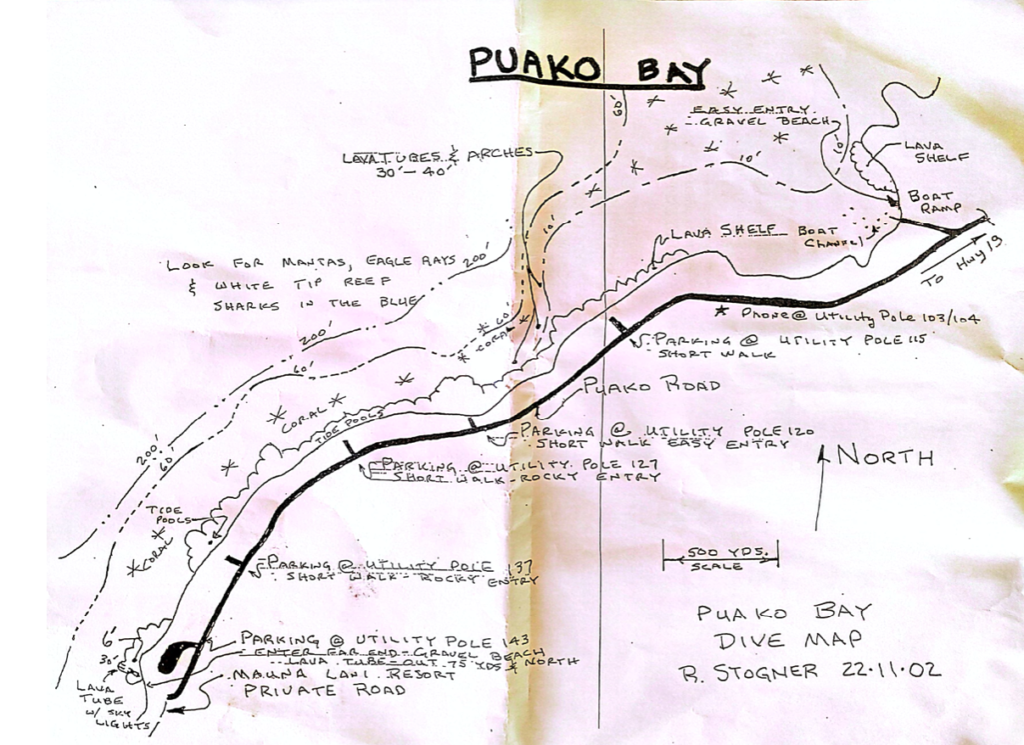
Lisa and I left the Hale Kona Kai condo before 7:00am and were parked around 7:45.
First thing about diving Puako: be sure to mark your exit point. When you’re out in the ocean, everything looks the same. We hung a big orange/white striped beach towel off a tree on the shore.
The entry at Puako is the only bit of drama in the entire experience. There is slippery lava that you have to walk/craw over to reach the sandy bottom or deep enough that you can swim. I highly recommend going at high tide so you get deeper quicker.
The other recommendation: wear heavy booties, both for lava and urchin protection, meaning strapped, rather than full-foot, fins. Carry your fins in, and walk holding hands (three points of support) over the lava. I’m making it sound worse than it is – don’t let me put you off. Just be properly prepared, plan and time your entry right, and Bob’s your uncle.
There are mooring buoys all over the area. We took aim at the “middle” one, a heading of 15° off the beach. If you’re an old beach diver like Lisa and I are, the swim isn’t that daunting. And on a pretty Sunday morning in August, it’s downright enjoyable. Roll on your back (saves air for the underwater bit), kick slow and take your time.
We got almost to the buoy, when I looked down and saw a drop-off to about 40′ directly below us. “Look what I found.” I took a compass reading on our towel – sure enough, 195° – math is cool.
We found a sand bottom in 20′ at the edge of the drop-off, and went down there to adjust straps, clear masks, etc. Then we tumbled over and went down toward the sand. There is a gentle slope down to maybe 100′ – we hung around 50-60′. “Left or right?” I asked Lisa. Shrug. Shore dives are so fun. I picked left (westward) and we started cruising along the slope, enjoying the finger coral. Less than five minutes after we descended, this guy swam past us.
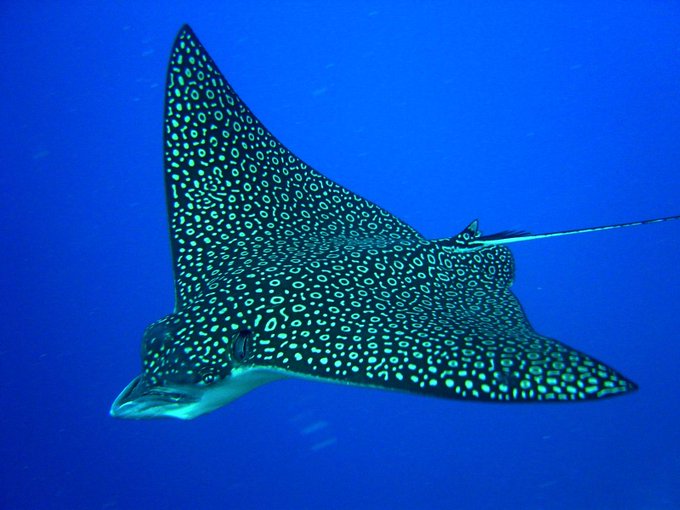
I turned to see if Lisa was watching – her eyes were smiling ear to ear, so yeah. He came back 3-4 times. Lisa later said she saw him head up into the shallows. But it was fun to have him around for a little while.
Here’s the thing about drop-offs – I’m always turning to look out that way, because something amazing can swim past. Unlike the nature specials and Shark Week, the critters don’t have a swelling soundtrack to announce their arrival. I’ve always wondered how many astonishing sights I’ve missed because I was concentrating on something on the shoreward side. This wasn’t astonishing, but it was definitely way cool:
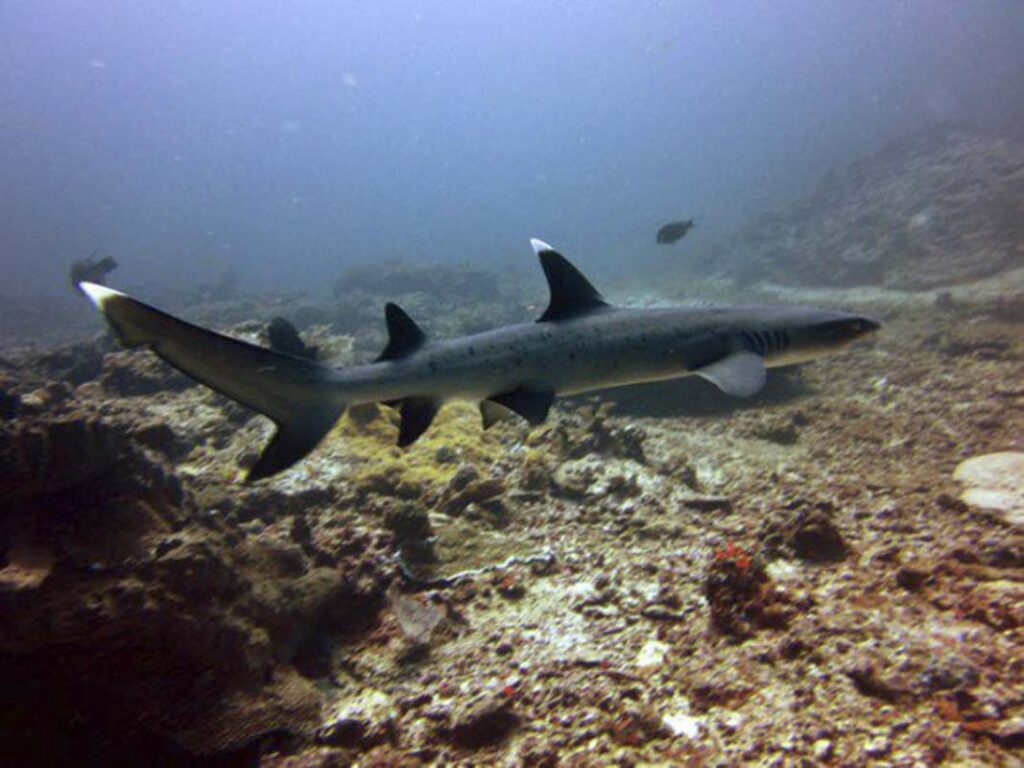
She was swimming parallel to us along the sand bottom, 40′ below us. If she was aware of us, she didn’t indicate it – she just passed us at a leisurely pace and disappeared into the gloom.
I should note that there were a bazillion reef fish of every sort. The outer slope reefs had clouds of anthias covering them. The big critters were fun, for sure. But even without them, the usual reef suspects made the dive delightful.
We continued on until we came to a weird topographic feature. As I mentioned above, there was a sand bottom at about 40′ below us to the right. But suddenly that sand bottom dropped off into the abyss in the direction we were going. And the slope that we were paralleling also dropped down into that same deep blue. It was beautiful. And freaky. We had to stop for a couple of minutes and just dig that particular junction.
Then it seemed like time to head back to slightly shallower water, so we headed up the slope. By sheer accident we ran smack into the mooring buoy one west of the one where we’d descended. I looked up and discovered that there was a boat attached to it, which explained the prop sounds we’d heard earlier in the dive.
My recollection of previous dives at Puako (a decade prior) was amazing topography, with canyons, arches, and towers of coral. I’d been missing that during the first part of the dive, and thought maybe I’d misremembered.
We just had to get to the right place. As we came up into 30-40′ of water near the second buoy, the canyons and arches appeared. I took a scientific wild-ass guess on the direction back toward our original buoy and we headed that way.
But we were careful to zig in and out toward shore to get the full joy of the terrain. Towers of coral. Archways that you could swim through, were they not full of big fish that you’d disturb. Dead-end canyons that looked like something out of a bizarre underwater cowboy western.
It was in one of those canyons that I had a memory of our friend Celeste Fowler. Man. We lost Celeste to cancer in 2004, and here 18 years on, it still stings. She was the most amazing diver, and just a magical spirit. Somehow I’d had the privilege of doing a dive with her at Puako – just the two of us. We were in one of those canyons, and Celeste was scanning her light under a ledge, when she waved me over. There was a whitetip shark sleeping on the sand under the ledge. We spent a few minutes enjoying that treat, then turned to head out. The canyon opened up in front of us, leading toward the drop-off – the view was stunning.
Celeste reached out and we held hands for a little while as we swam down the canyon. I hope that memory stays with me forever. Dives at Puako will help me keep it.
After meandering back in the general direction of home, Lisa and I thought it was time to think about finding the actual exit point. We found a sand patch, and I indicated that I was going to go up, get a proper compass reading, and come back down. But looking up, I saw a green sea turtle swimming over. It was surrounded by a dozen small jacks that were using its shell as a parasite cleaning station. One by one, the fish swam up to the turtle and wiped their sides against its shell, presumably to wipe parasites off themselves. Whether this has any benefit for the turtle, who knows?
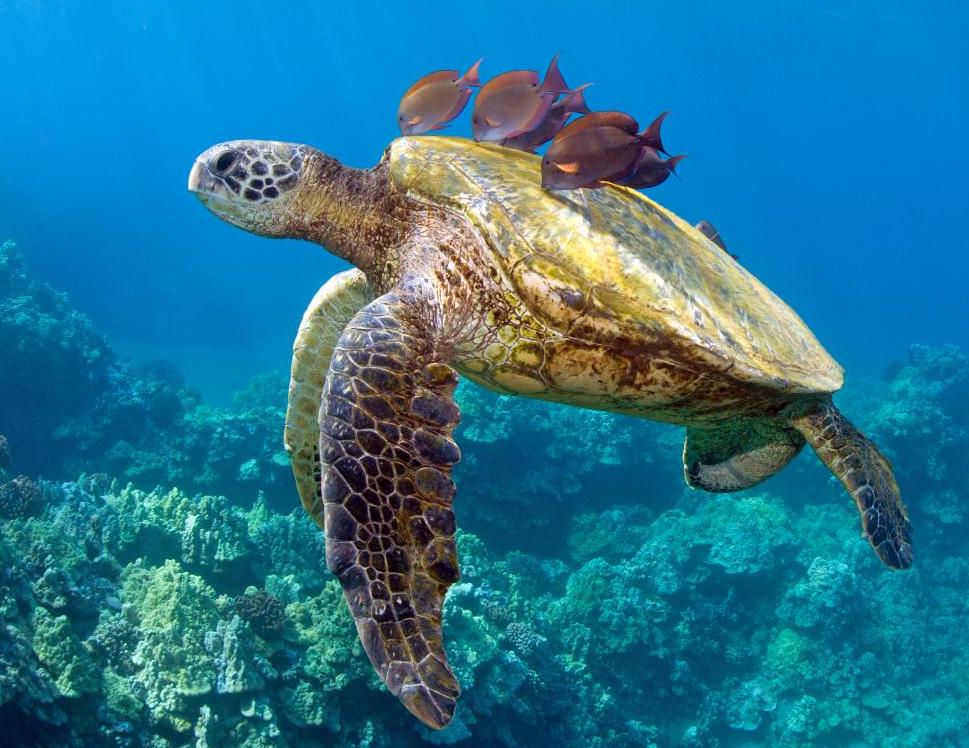
After that show was over, I went on up to the surface to get a compass reading. Miraculously, we were close to smack on the path that we’d taken out at the beginning of the dive (I’m just not that good at navigation) – home was at 200°.
We stayed underwater as far as possible because (a) it’s more fun, (b) you see more, and (c) it’s easier kicking underwater. Ultimately, we were at about 6′, so I gave up and ascended, much to Lisa’s annoyance.
We kicked on in, made our way across the lava, fins in hand, and got back to the shore. 65 minutes underwater, every one awesome.
Standing at the car, Lisa said, “That was great. Now let’s get lunch at Harbor House, then drive down to Two Step, and go snorkeling.” Gotta get full value for your last day in Kona.
Random shore diving note
Over the years, I’ve tended to weight myself more heavily than the textbooks suggest. Even the textbooks have gotten better about adding weight since my early training days in the 1980’s, because it’s important to be able to comfortably stay at your 15-20′ safety stop, even with an aluminum 80 cu. ft. tank that has added 3-5 lb. of buoyancy since it was full. But what the textbooks don’t talk about is the convenience and safety of being able to stay submerged at 15′, or 10′, or even 5′ on your return from a shore dive.
Experiment with a couple of extra pounds. I don’t think you’ll notice the difference at depth, but you’ll be glad that you’re able to still enjoy the dive as you swim back at a depth of 10′ toward the shore at Puako.
